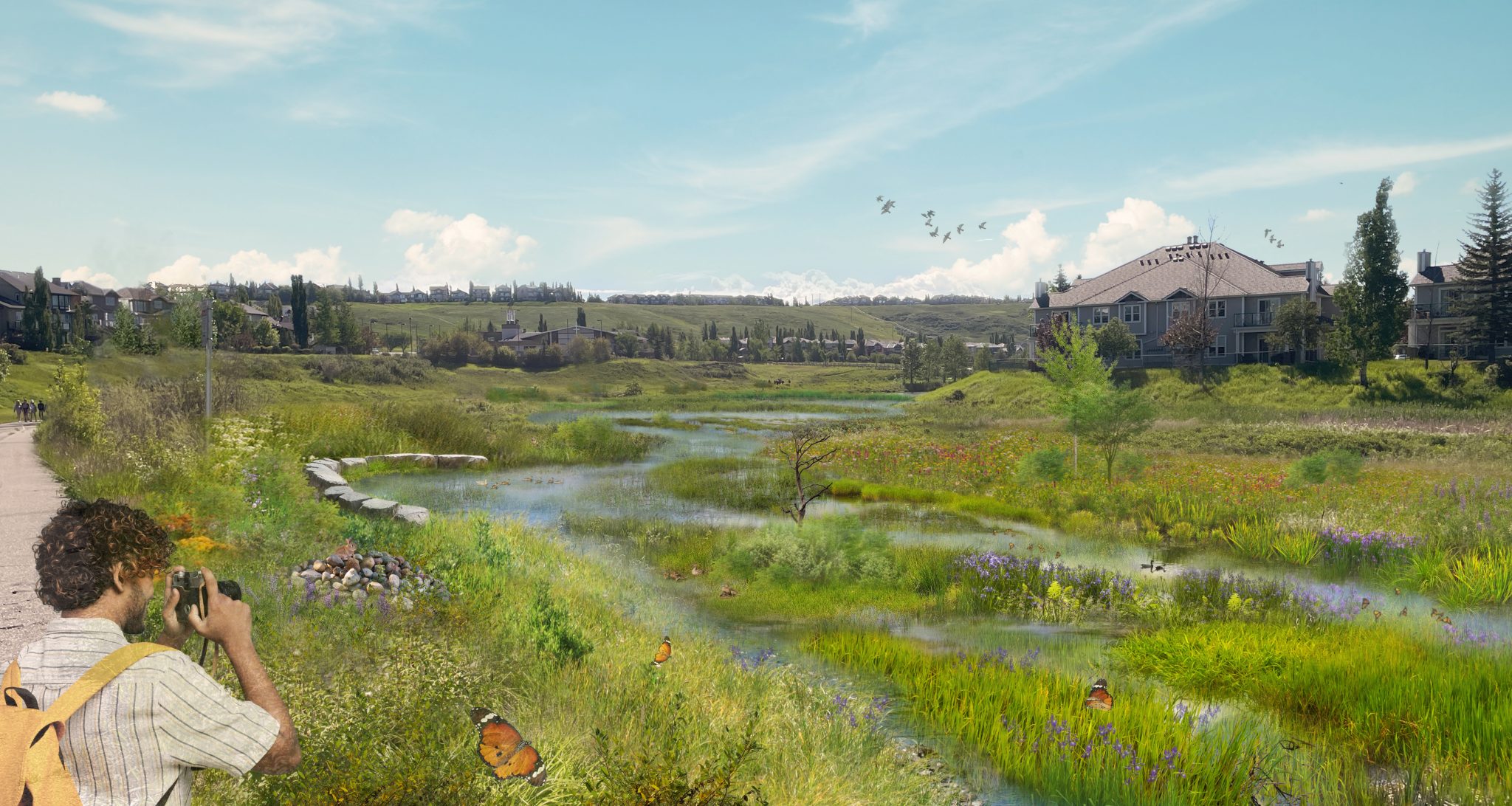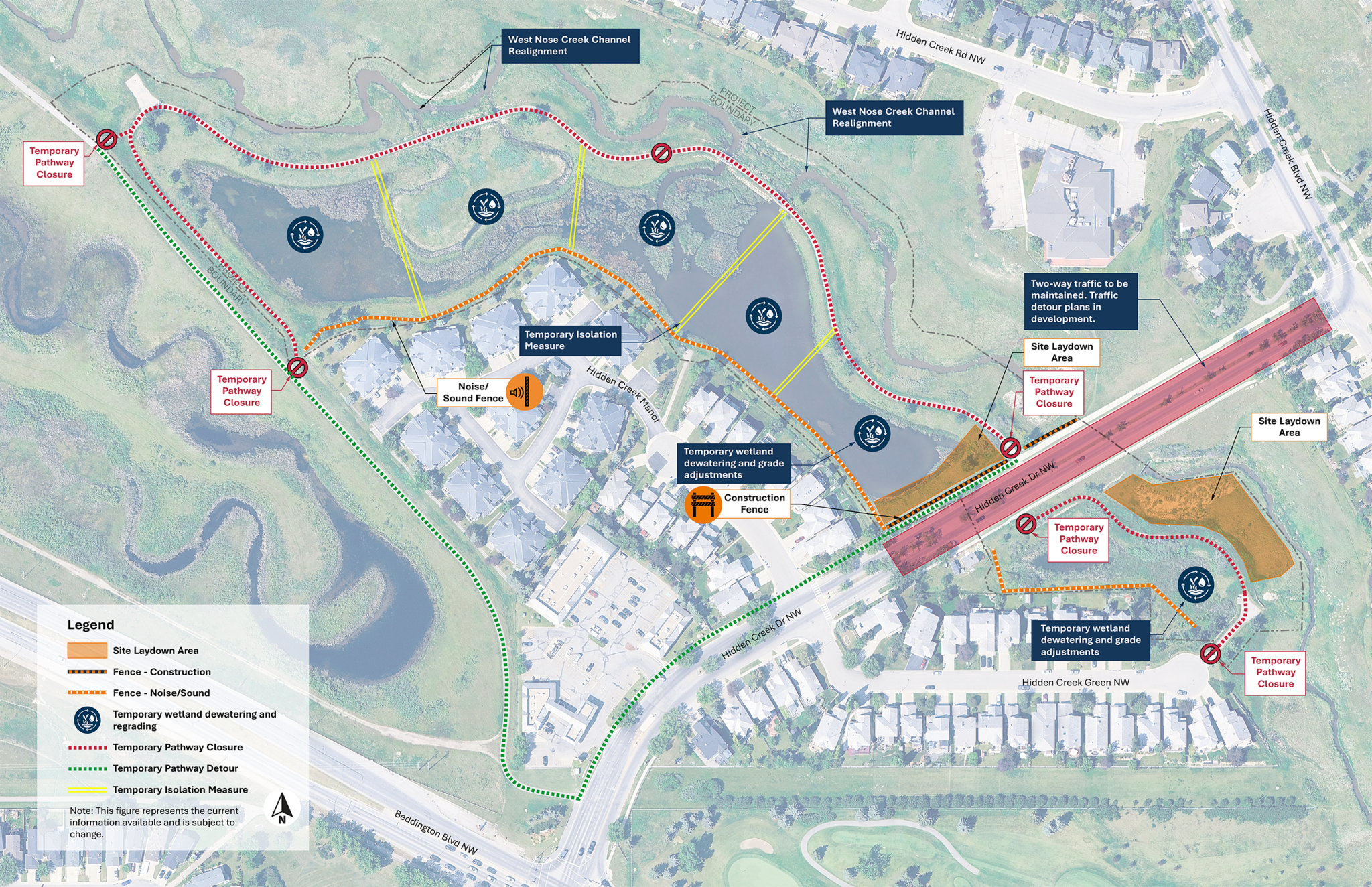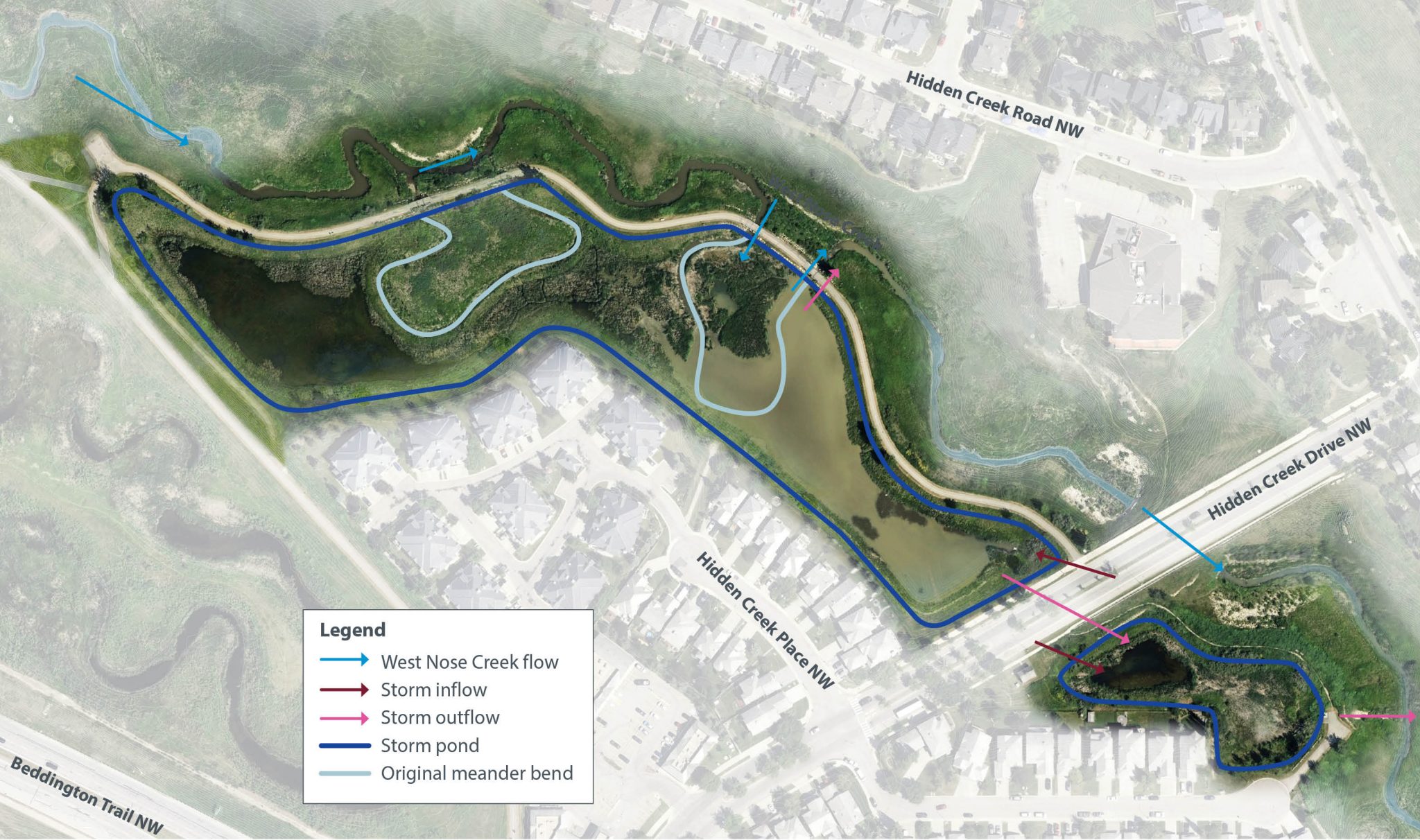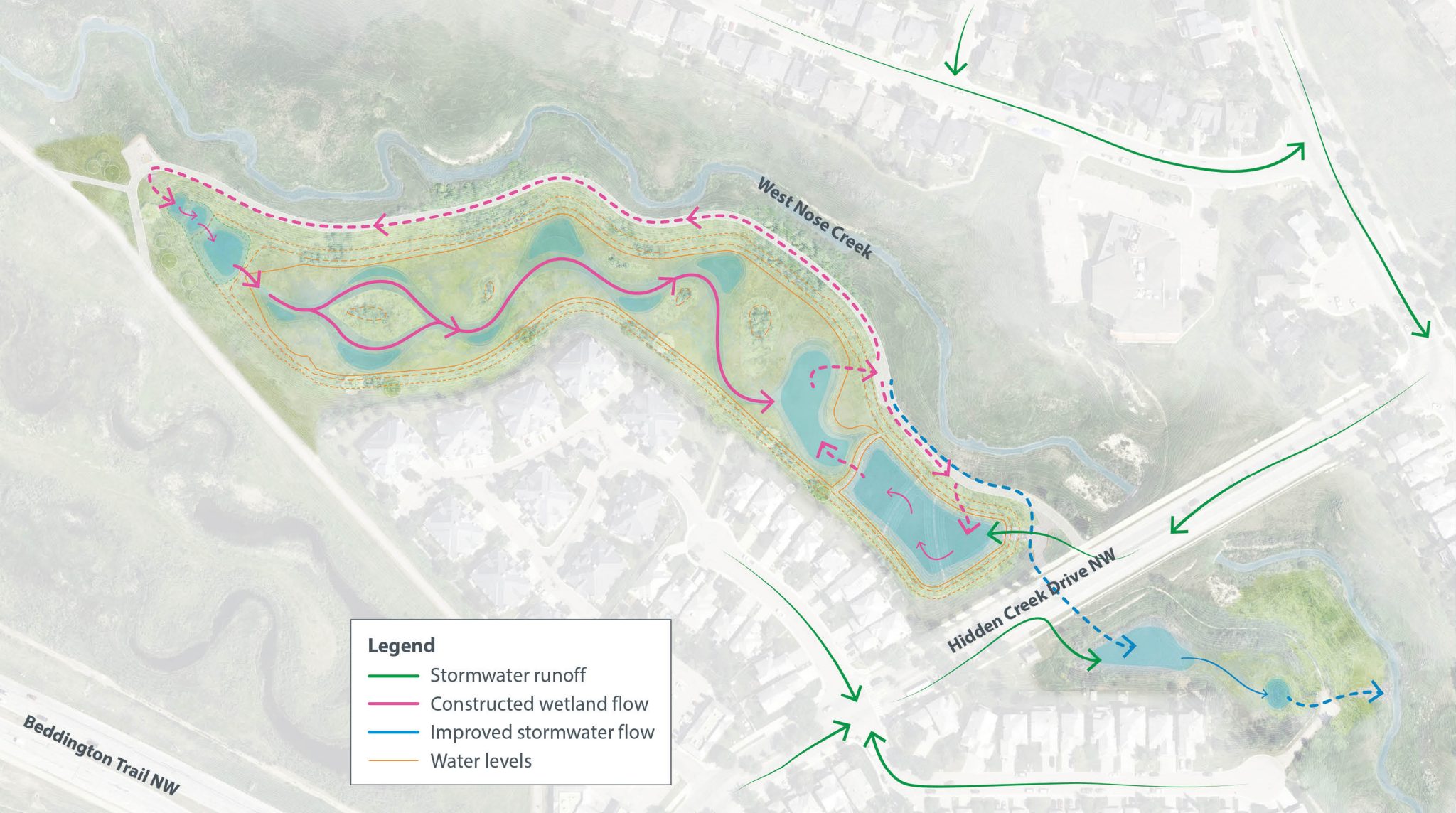Hanson Ranch Wetland Improvements
Project Update - November/December 2025
We continue our critical preparation work that requires formal approvals before major construction can proceed.
One key step has been dewatering the pond, which is necessary for safety and environmental compliance. Before freeze-up, we also successfully relocated fish from the North pond to West Nose Creek and are in the process of relocating fish from the south pond.
In the coming months through fall and winter, you’ll continue to see progress on topsoil stripping, ongoing water management efforts, and removal of sediment. Freezing temperatures will allow heavy equipment to work more effectively in areas that have been too soft and muddy during the warm fall, allowing sediment removal from the North pond.
Thank you for your patience and understanding as we continue construction on this important project.
What to expect during construction
Timeline
- Mobilization begins
- South Cell works:
- Sediment removals
- Outlet structure replacement
- North Pond:
- Dewatering (in stages)
- Sediment removals
- Emergency Escape Route upgrades
- Hidden Creek Drive:
- Pipe and manhole replacements
- Other preparatory works
- Continued dewatering and sediment removals in the North Cell
- Start of earthworks (excavation, grading, etc.)
- West Nose Creek diversion
- Creek re-alignment channels and bioengineering
- Pumped recirculation system installation
- Dam construction
- Ongoing underground utility works
- Landscape contouring
- Maintenance road and pathway installation
- Tree/shrub planting
- Topsoil and seeding
- Partial demobilization and site cleanup
- Final landscaping and plantings
- Facility commissioning
- Pathway opens to the public by end of Q2
- Long-term maintenance and monitoring
Timelines are dependent on several factors such as; regulatory permitting, complexity, available budget, supply chain, inclement weather and/or other unexpected circumstances.
About the project
The Hanson Ranch Wetland is a constructed wetland type of storm pond that was built in 1999 to retain stormwater runoff in the Hanson Ranch/Hidden Valley community near West Nose Creek.
Since it was initially constructed, the facility has deteriorated through natural processes including wind/wave action, sediment movement and settling within West Nose Creek that have resulted in it not functioning as designed. Because of this, the storm pond is no longer compliant with environmental regulations.
In consultation with municipal, provincial, and federal regulators, we’re undertaking a redesign to improve the facility and meet regulatory requirements. Improving this constructed wetland will help reduce the risk of impacts to West Nose Creek and provide an opportunity to enhance the surrounding park area.
Map of current conditions
Click image to expand
Project outcomes and improvements
The Hanson Ranch Wetland Improvements project is being undertaken to:
- Protect the creek and the surrounding environment to meet regulatory requirements.
- Support stormwater storage and release water to West Nose Creek in a controlled way.
- Improve quality of water leaving the storm pond.
- Reduce stagnant water to minimize the risk of odor issues.
- Restore and enhance wildlife habitat.
- Improve constructed wetlands to help offset wetland losses.
- Reduce the risk of future damage due to environmental degradation, thus keeping maintenance needs and costs as low as possible and minimizing community impacts.
- Continue to occupy a similar footprint and blend into the natural environment.
- Provide access to the area and improve amenities such as pathways and benches.
Stay connected
Sign up for email updates to receive news and notices about the project.
Connect with the project team
For more information, please contact the project team at:
Noxious weeds
If you have concerns about noxious weeds on City property. Please visit Pest Management for more information or call 311.
Document Library
Improved constructed wetland map
Click image to expand
Rendering of the improved constructed wetland

Additional information about constructed wetlands
There are 3 types of storm ponds: Dry, Wet and Constructed Wetland (Storm ponds in Calgary). All types of storm ponds capture and contain stormwater for a period and release it more slowly, helping to reduce the rate of runoff, thereby reducing the potential for flooding and erosion downstream.
Constructed wetlands can improve sediment and nutrient filtering to a greater degree than Wet and Dry Ponds. This helps return cleaner water to our rivers and streams. They hold water during droughts and help replenish groundwater and replenish water in the atmosphere through evaporation. They also provide valuable habitat for a diverse range of plants and animals.
Project location
The storm pond is located north of Beddington Trail, north and south of Hidden Creek Drive N.W. and east of Stoney Trail N.W.
Environmental protection
The Hanson Ranch Wetland will be undergoing a significant amount of construction and requires careful consideration of the environment that is within the project boundaries.
Environmental studies
Prior to main construction, several studies have been completed to identify or investigate environmentally sensitive areas within the constructed wetland.
Study types
Soil quality
Soil quality
Test soil quality to inform how it will be managed during construction. Boreholes drilled around the constructed wetland provided soil samples that were studied to determine soil conditions.
Groundwater
Groundwater
Test groundwater quality to inform how it will be managed during construction. Groundwater monitoring wells installed at various areas around the constructed wetland provided groundwater samples that were tested to determine conditions.
Wildlife habitat
Wildlife habitat
Assess and evaluate potential impacts on vegetation, wildlife, and wildlife habitat.
Fish habitat
Fish habitat
Identify fish species and breeding areas within the project vicinity.
Wetland
Wetland
Identify and classify natural wetland areas around the project.
Tree inventory
Tree inventory
Identify and classify trees within the project area to reduce and prevent damage to trees during construction and/or replant accordingly.
Frequently asked questions
Construction
Why is this project required?
Currently the Hanson Ranch Wetland storm pond facility cannot be operated as it was originally designed and isn’t compliant with the Environmental Protection and Enhancement Act approval. The facility is also not compliant with the Water Act because the original design incorporated West Nose Creek within the facility. In addition, the earth berm separating the storm pond facility from West Nose Creek is now considered a dam under the Alberta Dam and Canal Safety Directive and will require approval under the Water Act.
The improvements are needed to meet current municipal, provincial, and federal guidelines and regulations, and to improve the overall function of this constructed wetland so that it can meet stormwater storage demands and release water to West Nose Creek in a controlled way. Completing this work will help to improve water quality and reduce erosion in West Nose Creek and will reduce maintenance needs, thereby lowering costs and minimizing community impacts.
How long will it take to complete the project once construction begins?
The project is set to begin construction during the first week of September 2025 and it will take about two years to construct. Maintenance and restoration by the contractor will take another four to five years.
When will more details regarding the improvements to the constructed wetland be available?
Typically, details are provided prior to construction. We will host an information session as part of phase 3 of the engagement process before construction begins.
Will you collect any input from the community when making these improvements?
Due to the nature of this project, we must first work on a design for the constructed wetland that complies with the current regulatory requirements, standards, and guidelines. As part of the second phase of the engagement process we are collecting feedback on public realm improvements (i.e. social spaces, amenities, and materials) from the community between Oct. 21 and Nov. 4, 2024.
Why has the project been ongoing since 2016?
The need to review the condition and operation of the Hanson Ranch Wetland was originally identified in 2016. Planning and design work (engaging with federal, provincial, and municipal regulatory agencies and other regulatory groups) began in 2016; although, design completion and construction were paused. Since then, we have completed a condition assessment, looked at conceptual options, and completed preliminary geotechnical investigations. We’ve also started conversations with federal and provincial regulators.
The project did not receive funding to proceed to the design phase until Q4 of 2018.
What will be done to minimize parking and traffic congestion during construction?
The contractor is currently developing a traffic management plan(s) which will aim to minimize disruption to the public while balancing the need for efficient project execution. We will be maintaining two-way traffic on Hidden Creek Drive. Information related to impacts will be shared with the community prior to construction during the third phase of our engagement process and will continue during construction.
How will the improvements address odors?
The water quality improvements, including the stormwater recirculation system, will help reduce nutrient loads and maintain continuous flow during the ice-free months, which are typically a cause of odors. Visit Storm Ponds in Calgary FAQs for more information.
Will these improvements address noxious weeds in the area?
Pests like noxious weeds are common throughout Alberta. We’re working to reduce weed establishment before construction.
Weed management will continue throughout construction and during the maintenance period after construction, while new vegetation is establishing. If you have specific concerns about noxious weeds on City property, call 311.
What efforts will be made to restore and enhance the area?
A Habitat Restoration Plan is part of the design process and is required to be developed in collaboration with biologists. We will be replanting using a large variety of native plants (grasses, sedges, rushes, shrubs, etc.) that were selected to be included in each habitat zone. See infographic on the Engage Page. We are also required to comply with all provincial and federal legislation and regulations. For more information on habitat restoration, click here.
What is being done to mitigate the sound of the construction equipment back-up beepers?
We understand the disturbance the sound of the equipment’s back-up beepers cause and are taking steps to mitigate this as much as possible while still ensuring a safe environment for the construction workers. We have asked the Contractor reduce the amount of time and/or occasions when equipment is operating in reverse which would reduce the amount of noise generated from the back-up beepers. Additionally, our Contractor operates the latest equipment and abides by the appropriate safety measures, including using back-up alarms which are a standard safety practice on active construction sites.
Pathways
Will this work impact the nearby natural area/pathway/sidewalk?
There will be impacts to the nearby natural area/pathway/sidewalk during construction, but once construction and maintenance work are complete, the area will be returned to the same uses (i.e. constructed wetland within the natural area/pathway/sidewalks replaced to similar or better condition than prior to construction.) See section on Construction impacts.
Can the pathway immediately adjacent to the constructed wetland be maintained in the winter?
The snow on the pathway adjacent to the constructed wetland cannot be cleared at this time due to the current conditions and infrastructure in place. Once the improvements are made, we will re-evaluate for clearing in the future. In the meantime, the regional pathway along Hidden Creek Drive NW is currently snow cleared and connects to all nearby pathways. For additional information on Pathways Snow Clearing, and to view a map for the areas cleared, click here to learn more.
Does this work include any improvements to the sidewalks on Hidden Creek Drive immediately adjacent to the Hanson Ranch Wetland?
Yes, the sidewalks immediately adjacent to the Hanson Ranch Wetland that are in poor condition or that are impacted during construction will be repaired as part of the project.
Does this work include any improvements to the sidewalks on Hidden Creek Drive immediately adjacent to the Hanson Ranch Wetland?
Yes, the sidewalks immediately adjacent to the Hanson Ranch Wetland that are in poor condition or that are impacted during construction will be built to better condition repaired as part of the project.
Storm Pond
Can this constructed wetland be grandfathered?
We are not able to grandfather the facility to bypass needing to meet current regulations. This facility is not compliant with original approvals or existing regulations; therefore, grandfathering is not an option.
Will the pond be smaller?
With the new design, we plan to continue to occupy a similar footprint of the storm pond and blend into the natural environment; therefore, there may be more vegetation in some areas. The additional vegetation is part of a well-designed constructed wetland and helps improve water quality.
Why can the storm pond not be used for recreation activities such as skating?
It’s not safe to skate, walk or play on storm ponds Here’s why:
- The water in these ponds contains sediment and contaminants (e.g. road salt, vehicle fluids, bacteria, fertilizers, pesticides) that are collected as water travels through the community on their way to the storm pond, which can weaken the ice.
- Water levels are constantly changing as water moves between inlet and outlet pipes creating unstable air gaps between the ice and water.
For more information, please visit our webpage related to storm pond safety
Is fishing permitted in the storm pond?
As per the Stormwater Bylaw 37M2005, fishing is prohibited within Calgary storm ponds. It is also illegal to stock or release fish into a storm pond. Some fish species that have been artificially placed in storm ponds by the public are considered invasive and can have harmful impacts on native fish populations.
Wildlife
What measure(s) will be taken to minimize/mitigate wildlife disruption?
The project requires a Biophysical Impact Assessment (BIA) which is reviewed and approved under the City of Calgary’s framework. The BIA will identify affected wildlife species and habitat and will recommend efforts to help mitigate impacts. The BIA must be approved before construction can start. More information will be shared before construction.
One of the objectives of the Hanson Ranch Wetland Improvements is to restore and enhance wildlife habitat and native vegetation for the long-term benefit of the area.
Some examples of mitigations and best management practices we will implement include, but are not limited to:
- A large part of mitigating impacts to wildlife is the timing of when we complete the works. We need to respect the regulated wildlife windows such as clearing of vegetation outside of the migratory bird nesting window of April 1 – August 30th. Realignment of the West Nose Creek channels need to occur between June and end of September. This is the best timing of placing vegetation to restore and enhance wildlife habitat. There will be periods of time that we are not able to construct, including some short winter periods. The Contractor’s schedule includes winter work, which helps to reduce wildlife conflicts . We will continue to update the project schedule as the project progresses.
- Remove the existing redundant paved pathway at the N.W. end of the project where there is the existing regional pathway. This redundant pathway will be replaced with native vegetation consisting of grasses, wildflowers, and shrubs.
- Build an improved connection from the maintenance access/paved pathway along the north side of the Hanson Ranch wetland’s north cell.
- Design water level control devices using today’s best practices, to reduce the risk of wildlife/human conflict.
- We have also designed the facility to have areas that require regular maintenance (sediment basins) close to Hidden Creek Drive to minimize impacts on wildlife and residents.
- Minimize the extent of disturbance to established vegetation where possible.
- Install temporary fencing and/or signage to minimize wildlife and human encounters during construction and maintenance. Exclusion fencing will be installed to minimize potential for amphibians and snakes to re-enter the site once they have been relocated to areas outside of the construction zone.
- Collect and relocate sensitive species during construction.
- Incorporate design features to improve wildlife habitat within the constructed wetland such as:
- Islands.
- Cobble piles and boulder banks.
- Snags / coarse woody debris.
- Increased diversity of native vegetation.
- Erosion and Sediment controls
- Environmental Construction Operations Plan
There are beavers in the area, what will happen to the beavers?
Beavers are good for our environment, but also pose some challenges.
One of the main functions, and regulatory requirements, of this type of infrastructure is to be able to manage high water levels during storm events and unfortunately, beavers can negatively impact this important function.
Our goal is to design the facility so that beavers can't impact it the way they have in the past, while recognizing it is possible that beavers may choose to live within the deepest parts of the storm pond. We believe the design allows for this once vegetation has established. We will endeavor to minimize impacts to beavers during future maintenance work if they choose to reside within the constructed wetland type of storm pond.
The City’s practice is to try and strike a balance between the health of the surrounding areas and the wellbeing of the beavers. To learn more about beavers, the challenges they present, and our approach to beaver management, please visit our Beavers webpage.





